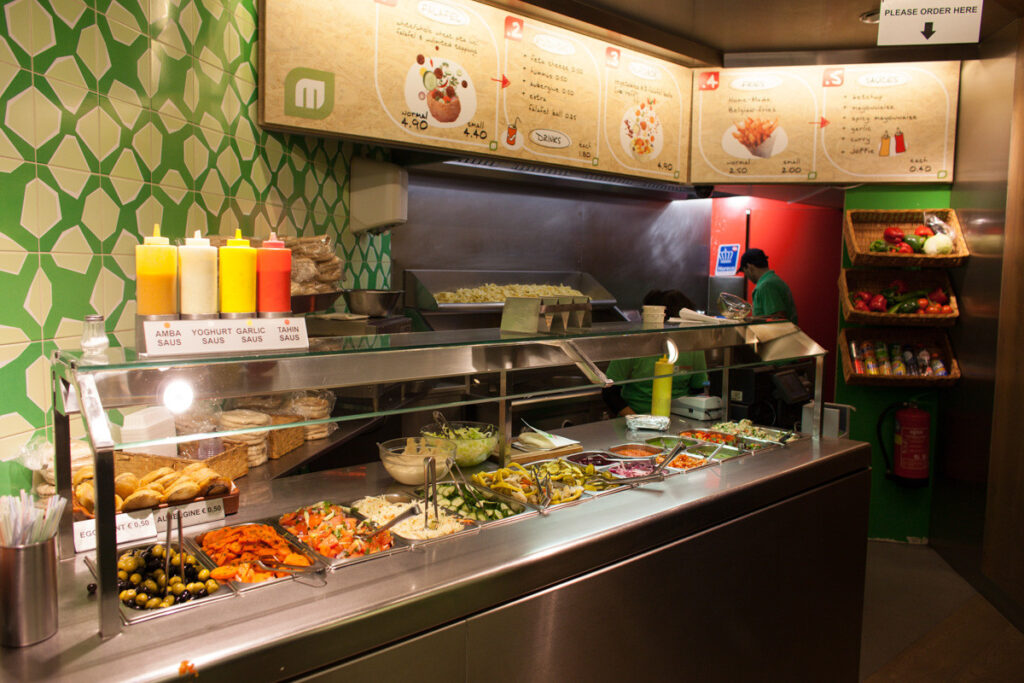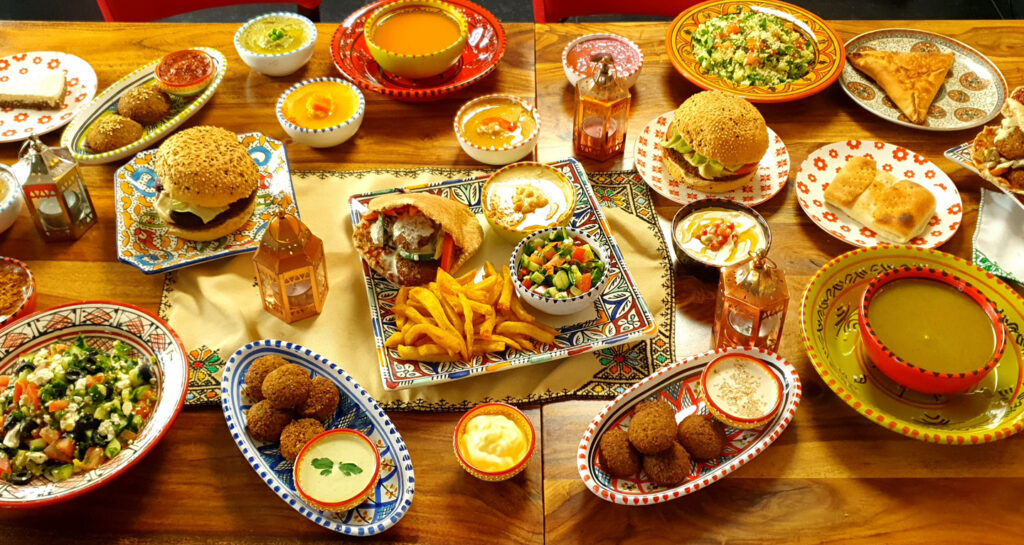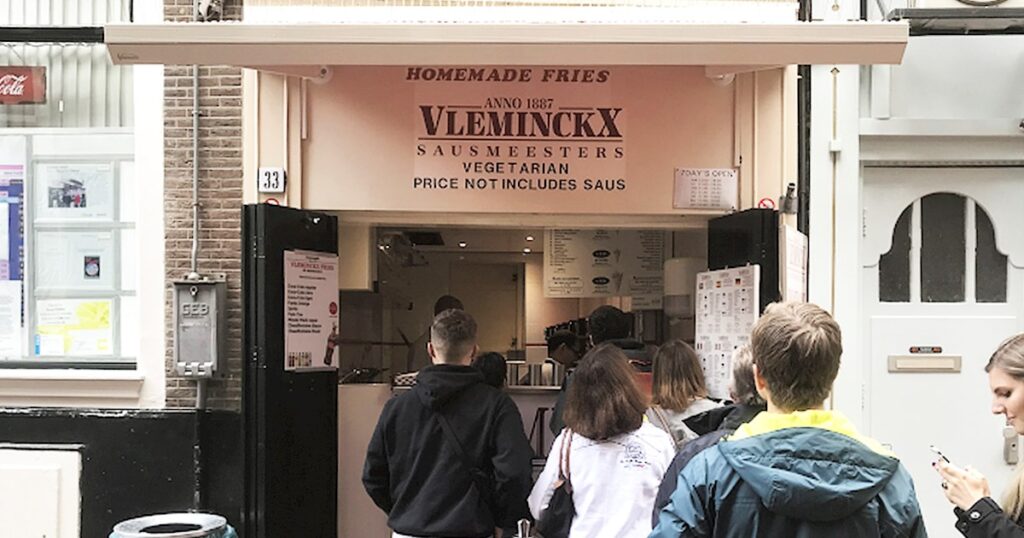Food & Drink
10 BEST Amsterdam Bars
At vero eos et accusamus et iusto odio dignissimos ducimus qui blanditiis praesentium voluptatum deleniti.
Published
7 years agoon
By
Kenta Fox
It may be Europe’s nightlife capital – but that’s not all. The best bars in Amsterdam show this city’s very much a bar destination too
You might say it’s Europe’s culture capital – just walk down any road off the Amsterdam streets and that should become quite clear. But it’s always that Amsterdam city has the best bars and clubs in Europe. We have listed 10 best Amsterdam Bars for you. Don’t forget to make a reservation before go!
Best bars in Amsterdam
1- Cafe Pollux

2- Law & Order Cocktail Bar

3- Susie’s Saloon

Nice Saloon is located on the edge of the famous Red Light District, Susie’s Saloon is a tight location to feel the sights and sounds of the city.
Adress: Oudezijds Voorburgwal 254, 1012 GK Amsterdam
Map: https://g.page/SusiesSaloon?share
4- BELUSHI’S

Belushi’s won’t let you down if you’re looking for a bar that turns into a party as it gets later. Right on the edge of the Red Light District, this is a prime spot for partying and starting off a bar crawl.
Adress: Warmoesstraat 129, 1012 JA Amsterdam
Map: https://g.page/BelushisAmsterdam?share
5- BAR OLDENHOF

Bar Oldenhof. This old-fashioned speakeasy is oozing with excellence and charm. Located in the heart of the city, you’ll enjoy the lively atmosphere at this cozy spot whilst drinking some of the best cocktails in Amsterdam.
Address: Elandsgracht 84-H, 1016 TZ Amsterdam
Map: https://goo.gl/maps/JrNUuJw3gdKoPzq36
Webpage: http://www.bar-oldenhof.com/
6- TON TON CLUB WEST

Map: https://g.page/tontonclubwest?share
Webpage: https://tontonclub.nl/
7- Café Belgique

Map: https://goo.gl/maps/34ffhMiMmL3wG58W6
8- Tales and Spirits

Address: Warmoesstraat 129, 1012 JA Amsterdam, Netherlands
9- Café Old Sailor

Hold on to your hat as you spin on an aerial swing at the Dam Square carnival. However you spend Koningsdag, it’s easy to friends wandering the streets, and poking into bars and coffeeshops until dawn around this area.
Address: 39-A Oudezijds Achterburgwal
10- In’t Aepjen

Founded in 1519, In’t Aepjen is one of the city’s oldest brown bars (the Dutch version of an English pub), and the cozy room regularly draws a large crowd given its proximity to the main train station. It’s also curiously decorated with monkeys—monkey statues, stuffed monkeys, and monkey posters.
Address: Zeedijk 15-1, 1012 AN Amsterdam
Food & Drink
Best sushi restaurants in the Netherlands
Published
1 year agoon
29/06/2023By
Berry Fox
Where are the best sushi restaurant in the Netherlands? Fancy a nice portion of sushi? That’s a good thing because, in addition to the best sushi in Amsterdam, the Netherlands has plenty of places where you can enjoy this specialty. From home delivery to going out to visit your favorite sushi place or the best all-you-can-eat sushi, it’s all possible. So all sushi lovers pay attention because we list the best sushi restaurants in the Netherlands for you (in random order), from Amsterdam to Maastricht.
Best sushi restaurants in the Netherlands
1. De Japanner
2. A-Fusion
With no less than five locations, you always have a place at A-Fusion. The restaurant is located in Amsterdam (Zeedijk), and can also be found in Volendam, Naarden, Baarn and Loosdrecht. All branches are beautifully decorated and the menu will make your mouth water spontaneously. Here you will certainly eat one of the best sushi in the Netherlands. Also available via Thuisbezorgd.
3. Miyagi & Jones
Bu gönderiyi Instagram’da gör
MIYAGI AND JONES UTRECHT (@miyagiandjonesutrecht)’in paylaştığı bir gönderi
Advertisement
4. Tiger Mama
Bu gönderiyi Instagram’da gör
TIGER MAMA UTRECHT (@tigermamautrecht)’in paylaştığı bir gönderi
Advertisement
5. Three
Bu gönderiyi Instagram’da gör
Restaurant Three (@restaurantthree)’in paylaştığı bir gönderi
Advertisement
6. MOOD
Bu gönderiyi Instagram’da gör
MOOD by Eveline Wu (@moodbyevelinewu)’in paylaştığı bir gönderi
Advertisement
7. Momiji Sushi
If you eat at Momiji Sushi, you can’t help but order as much sushi as possible. One look at specialties such as the Red Dragon or the White Shark Roll and you’re hooked. But it is more than worth it to take a look at the rest of the menu. Because where else can you find a sushi restaurant that not only serves sushi, but also fragrant curry, spicy ramen and a wide selection of bubble teas? Also available via Thuisbezorgd.
8. De Sushimeisjes
What if you are two girlfriends and you both really like sushi? Then why don’t you just start your own sushi place? That is exactly what these two girls from The Hague have done. The menu offers an enormous amount of choice – from the Pink Dragon Roll to the Torched Tuna Roll – which makes the hearts of many sushi lovers beat faster.
9. Thai Ichi
10. Sumo Oriental
Bu gönderiyi Instagram’da gör
Sumo Oriental Rotterdam (@sumoorientalrotterdam)’in paylaştığı bir gönderi
Food & Drink
Lunch in Leiden: These are the nicest lunch spots in the city
Published
1 year agoon
28/06/2023By
Berry Fox
Where to have lunch in Leiden? Leiden is much more than a student city. The city has romantic canals, and nice alleys and is best known because Rembrandt comes from there. Would you like to have a nice lunch in Leiden during your visit? Then here you will find the nicest (and especially tastiest) places to crash between activities. Would you rather have dinner or take a coffee to-go?
Lunch in Leiden: These are the nicest lunch spots in the city
1. CityHall
For an Italian lunch in Leiden, the best place to go is Trattoria Italiana City Hall in the old town hall of the city. Here you eat crispy pizzas, fresh pasta and anti pasti boards to share with your company. The location is also right in the center, a perfect stopover for a bite to eat at noon.
Bu gönderiyi Instagram’da gör
Trattoria Italiana City Hall (@cityhallleiden)’in paylaştığı bir gönderi
2. Bar Lokaal
Bar Lokaal is open all day for a tasty lunch in Leiden. You can have breakfast, lunch, dinner and drinks here from 08:30 until the late hours. The colorful terrace makes it inviting to sit down here during lunch, but wait until you see the menu! Brunch is from 9 to 12, but you can order from the lunch and dinner menu from 11 am. With the shared dining concept full of worldly dishes, you can eat your way around here.
3. Waag Leiden
4. Lot en de Walvis
Would you like to have lunch in Leiden on the water? Then Lot en de Walvis is the right place for you. You are sitting here at the Leiden harbor and with a bit of luck in the sun. The lunch menu is full of classics such as Eggs Benedict, American Pancakes and a focaccia Caprese. And are you coming on Sunday? Then you can also order the recovery breakfast to recover completely after a night of drinking cocktails.
Bu gönderiyi Instagram’da gör
Lot & de Walvis (@lotendewalvis)’in paylaştığı bir gönderi
Advertisement
5. Blossom by KP
This lunchroom is not only insta-worthy, you can also eat delicious food here. Not just a carpaccio sandwich, no you order Mediterranean dishes here that you can share with each other. They also have a special children’s menu, making this lunch in Leiden child-friendly.
6. Lunchroom Logica
Would you like a vegetarian lunch in Leiden? Then it is best to book a table at lunchroom Logica. As a vegetarian or vegan you can choose from many tasty options, because they do not cook with fish or meat. In addition, all dishes on the menu are 100% organic. In the summer you can take a seat on the terrace overlooking the Leidse canal.
7. Floor’s coffee en brunch bar
Do you have a gluten allergy? Then Floor’s coffee and brunch bar is the solution for you. They only serve gluten-free lunch dishes. So here you can have a delicious lunch in Leiden without constantly washing your hands and worrying about cross-contamination.
Bu gönderiyi Instagram’da gör
Floor’s coffee & brunch bar (@floors.coffee.and.brunch.bar)’in paylaştığı bir gönderi
Advertisement
Food & Drink
Exploring the Vibrant World of Falafel Shops in Netherlands
Published
1 year agoon
05/06/2023By
Berry Fox
Exploring the Vibrant World of Falafel Shops in Netherlands. Amsterdam, the capital city of the Netherlands, is renowned for its diverse culinary scene that caters to various tastes and preferences. Among the numerous delightful options available, falafel stands out as a popular choice for locals and tourists alike. The city boasts a vibrant array of falafel shops, each offering its unique twist on this Middle Eastern delight. Join us as we embark on a flavorful journey through the bustling streets of Amsterdam to discover the best falafel shops in town.
Exploring the Vibrant World of Falafel Shops in Netherlands
1. Maoz Falafel
One of the pioneers of the falafel scene in Amsterdam, Maoz Falafel has been serving delicious vegetarian and vegan falafel for over two decades. Located in the heart of the city, near the bustling Dam Square, Maoz offers a build-your-own falafel concept. Customers can choose from a variety of freshly prepared salads, sauces, and toppings to create their ideal falafel pita or bowl. Their falafel balls are crispy on the outside, tender on the inside, and bursting with authentic Middle Eastern flavors.
Address: Muntplein 1, 1017 CK Amsterdam

2. The Lebanese Sajeria
Tucked away in Amsterdam-West, The Lebanese Sajeria is a hidden gem that specializes in Lebanese cuisine, including their mouthwatering falafel. The standout feature of this cozy little spot is their freshly baked flatbread, made on a traditional saj griddle, giving it a unique taste and texture. The falafel is perfectly spiced, crispy on the outside, and soft on the inside, making it an irresistible treat. Enjoy your falafel wrap or plate with a side of aromatic hummus or refreshing tabbouleh.
Address: Wijde Heisteeg 1, 1016 AS Amsterdam
Website: http://thesajeria.com/menu/

3. Falafel Masters
Located in the Eindhoven, Falafel Masters lives up to its name by delivering exceptional falafel creations. Offering a range of vegetarian and vegan options, they pride themselves on using fresh ingredients and authentic flavors. Their falafel is handmade with care, resulting in a crispy exterior and a tender, flavorful center. Whether you opt for a classic falafel sandwich or a loaded falafel platter, you’re in for a delightful culinary experience.
Address: Edisonstraat 131-133, 5621 HM Eindhoven
Website: http://www.falafelmasters.com/menu-prijzen-prices-list/

4. Vleminckx de Sausmeester
While not a falafel shop per se, Vleminckx de Sausmeester is an iconic Amsterdam establishment that deserves a mention. This legendary French fry shop, located in the city center, is renowned for its wide variety of sauces. Pairing their crispy, perfectly cooked fries with their delectable falafel sauce creates a mouthwatering combination that locals and tourists rave about. Don’t miss out on this unique twist on falafel in a Dutch setting.
Address: Voetboogstraat 33, 1012 XK Amsterdam
Website: http://vleminckxdesausmeester.nl/

In Amsterdam, falafel shops provide a haven for both locals and visitors seeking delicious and diverse vegetarian and vegan options. Whether you prefer a classic falafel sandwich or a loaded plate with an array of flavors, Amsterdam’s falafel shops offer something for everyone. From the long-established Maoz Falafel to hidden gems like The Lebanese Sajeria, each shop provides a unique culinary experience that showcases the vibrancy and diversity of this beloved
Food & Drink
Discover the Sweet Delights: Best Cookie Shops in Amsterdam
Published
1 year agoon
03/06/2023By
Kenta Fox
Welcome to the enchanting world of cookies in Amsterdam! Whether you’re a local or a visitor, these delightful cookie shops in Amsterdam are sure to make your taste buds dance with joy. Get ready to experience the city’s sweetest treats as we take you on a journey through the best cookie shops that Amsterdam has to offer.
Explore Amsterdam’s top cookie shops for a sweet delight! From Van Stapele Koekmakerij’s heavenly chocolates to Original Stroopwafels’ authentic Dutch treats, satisfy your cravings. Discover The Good Batch, Van Wonderen Stroopwafels, and more. Indulge in Amsterdam’s cookie heaven today!

Best Cookie Shops in Amsterdam
- Van Stapele Koekmakerij: The Chocolate Cookie Haven Indulge in Amsterdam’s famous “chocolate cookie” at Van Stapele Koekmakerij. These freshly baked cookies with a molten white chocolate center will transport you to cookie paradise in every bite.
Website: Van Stapele Koekmakerij
Location: Heisteeg 4, 1012 WC Amsterdam - Original Stroopwafels: Authentic Dutch Delights Don’t miss the chance to savor traditional Dutch stroopwafels in Amsterdam. Head to Original Stroopwafels, where you can enjoy thin waffles oozing with caramel syrup, capturing the essence of Amsterdam’s culinary heritage.
Website: Original Stroopwafels
Location: Kalverstraat 190, 1012 XH Amsterdam - Van Wonderen Stroopwafels: Stroopwafel Heaven Immerse yourself in the irresistible world of stroopwafels at Van Wonderen Stroopwafels. Customize your stroopwafel with a variety of flavors and toppings. Don’t miss their delectable “waffle pops” for a cookie-like delight on the go.
Website: Van Wonderen Stroopwafels
Location: Kalverstraat 190, 1012 XH Amsterdam - Holtkamp: A Dutch Pastry Wonderland Step into Holtkamp, a renowned Amsterdam pastry shop established in 1902. Discover a delectable assortment of butter cookies, shortbread, and speculaas—spiced cookies that will transport you to the heart of Dutch tradition.
Website: Holtkamp
Location: Vijzelgracht 15, 1017 HM Amsterdam - Banketbakkerij Lanskroon: Timeless Treats in Amsterdam In the heart of Amsterdam, Banketbakkerij Lanskroon awaits with open arms and irresistible cookie delights. Savor their butter cookies, almond cookies, and the irresistible aroma of their gingerbread cookies.
Website: Banketbakkerij Lanskroon
Location: Singel 385, 1012 WL Amsterdam - Tony’s Chocolonely Super Store: Chocolate Cookies Galore Immerse yourself in the world of chocolate cookies at Tony’s Chocolonely Super Store. Explore their unique flavors and sustainable practices, and treat yourself to a delightful array of chocolate-infused cookies.
Website: Tony’s Chocolonely Super Store
Location: Oudebrugsteeg 15, 1012 JN Amsterdam
Prepare to embark on a cookie adventure like no other in the charming streets of Amsterdam. These exceptional cookie shops are just the beginning of your sweet escapade. Let Amsterdam’s mouthwatering delights and warm hospitality create unforgettable memories. Enjoy every delicious moment!

Where is cat friendly cafes in Amsterdam? A cat cafe is a type of cafe where customers can enjoy a beverage or snack while interacting with cats. The cats are typically friendly, social, and free to roam around the cafe, and customers are encouraged to pet, play with, or simply observe them while they enjoy their drinks or food.
Cat cafes originated in Taiwan in the late 1990s, but have since become popular around the world, especially in Japan, where they are a common feature of urban life. The concept has now spread to many other countries, including the United States, Canada, Australia, and various European countries.
In addition to providing a fun and relaxing environment for cat lovers, cat cafes often serve as adoption centers for cats in need of homes. They may partner with local animal shelters or rescue organizations to showcase adoptable cats and help them find permanent homes. Some cat cafes may also offer other services, such as cat yoga classes or workshops on cat care and behavior.
There are several cat cafes in Amsterdam where you can enjoy a cup of coffee or tea while spending time with some adorable feline friends. Here are a few options:
Cat Friendly Cafes in Amsterdam
1.Kopjes
This cat cafe is located in the East of Amsterdam and has a variety of cats that are free to roam around the cafe. They also serve a range of drinks and snacks.
Website: http://www.kattencafekopjes.nl/
Location: Marco Polostraat 211, 1057 WK Amsterdam

Cat Friendly Cafes in Amsterdam
2.Poeslief
This cat cafe is located in the West of Amsterdam and has a cozy and relaxed atmosphere. They serve coffee, tea, and homemade cakes, and have several friendly cats that love to cuddle.
Website: https://kattenpensionpoeslief.nl/
Location: Goudseweg 18, 2411 HL Bodegraven

Cat Friendly Cafes in Amsterdam
3.De Kattenkabinet
This unique museum and cat cafe is located in a historic canal house in the center of Amsterdam. The museum features a collection of art and objects related to cats, and the cafe has several resident cats that visitors can interact with.
Website: https://www.kattenkabinet.nl/
Location: Herengracht 497, 1017 BT Amsterdam

Cat Friendly Cafes in Amsterdam
Food & Drink
The hidden gem: Secret Garden Amsterdam
Published
1 year agoon
19/03/2023By
Berry Fox
A new restaurant called Secret Garden has recently opened in the heart of Amsterdam. The interior is a mix of green nature and contemporary art, in an exotic style.
Secret Garden was founded by Roy and Mike Poppes as an internationally focused and experienced restaurant. It opened its doors on the Reguliersdwarsstraat last August.
Its cuisine consists of a mixture of Peru and Japan, which is called Nikkei cuisine. Do you prefer the delicious Salmon Tataki with Honey Miso and passion fruit, or the Rib-Eye with Chimichurry & Crispy quinoa? There is an endless variety of food options.
Secret Garden is more than a restaurant. In addition to the wonderfully diverse cuisine, there is also room for a glass of wine or an exotic cocktail. All this while enjoying the best tunes from Secret Garden’s house DJs.
The name says it all. Besides the bar and restaurant, there is also a secret courtyard. Too Many Agency’s Architect Will Erens has outdone himself this time. Enjoy dinner at the Garden Restaurant, have fun with the DJ at the bar & lounge, have a cocktail in the green room or have a private dinner in the garden room.
The Secret Garden Amsterdam Menu
SECRET GARDEN is divided into three different areas. There is also a huge cocktail bar where you can dine in the Bar Lounge. There is a live entertainment program from Thursday to Saturday. With the plants coming from the ceiling and the use of bright colors in the Garden Restaurant, visitors imagine themselves in a tropical atmosphere. The Private Garden Room has its own bar and cocktail station and overlooks the monumental garden. There is room for sit-down dinners (up to 60 standing) and additional entertainment for groups of up to 46 people.
You can view the menu by visiting the website.

Where is the Secret Garden Amsterdam?
Address: Reguliersdwarsstraat 38, 1017 BM Amsterdam
Website: http://www.secretgardenamsterdam.com/
Food & Drink
The high-end restaurant and lounge in the Netherlands: Harbour Club Amsterdam
Published
1 year agoon
19/03/2023By
Berry Fox
The Harbour Club Amsterdam is a high-end restaurant and lounge located in the city center of Amsterdam, Netherlands. It offers a sophisticated and trendy atmosphere with a focus on seafood and sushi. The restaurant also serves a variety of other dishes, including meat and vegetarian options.
The Harbour Club Amsterdam is known for its chic and modern interior design, which includes a large aquarium and a spacious outdoor terrace overlooking the water. It has a lively atmosphere and is a popular spot for both locals and tourists.
In addition to dining, the Harbour Club Amsterdam also offers private event spaces for corporate events, weddings, and other special occasions.
What to Eat at Harbour Club Amsterdam?
The Harbour Club Amsterdam is primarily known for its seafood and sushi dishes, but they also serve other types of cuisine such as meat and vegetarian options. Some of the dishes you might expect to find on their menu could include:
- Fresh seafood dishes such as oysters, lobster, crab, and shrimp
- Sushi rolls and sashimi made with high-quality fish and seafood
- Meat dishes such as steak, lamb, and chicken
- Vegetarian dishes such as salads, risottos, and pasta dishes
- Side dishes such as truffle fries, mashed potatoes, and roasted vegetables
- Desserts such as cheesecake, chocolate mousse, and fruit sorbet
The Harbour Club Amsterdam also has an extensive wine list and cocktail menu, which includes both classic and modern drinks. They also offer various options for brunch, lunch, and dinner.
Visit the website to view the menu.

What to drink at Harbour Club Amsterdam?
At the Harbour Club Amsterdam, you can find a wide range of drinks including cocktails, wine, champagne, and non-alcoholic drinks. Some of the popular drink options at the Harbour Club Amsterdam are:
- Cocktails: The Harbour Club Amsterdam is known for its creative and innovative cocktails. Some of the popular options are the classic Mojito, Espresso Martini, and Margarita.
- Wine: The Harbour Club Amsterdam offers an extensive wine list featuring a variety of wines from different regions around the world. You can find both red and white wines, as well as rose and sparkling wines.
- Champagne: If you’re looking for something special, the Harbour Club Amsterdam offers a selection of champagne by the glass or bottle. It’s a great way to celebrate a special occasion or just enjoy a night out with friends.
- Non-alcoholic drinks: For those who don’t drink alcohol, the Harbour Club Amsterdam offers a range of non-alcoholic drinks, including mocktails, fresh juices, and smoothies.
- Beer: The Harbour Club Amsterdam also offers a selection of beers, including local and international brews.
Overall, the drink menu at the Harbour Club Amsterdam is diverse and caters to a range of tastes and preferences.

What is the prices Harbour Club Amsterdam?
The Harbour Club Amsterdam is a high-end restaurant and lounge that typically offers a premium dining experience with high-quality food, drinks, and service. Therefore, the prices are generally on the higher side compared to other restaurants in the area.
The exact prices will depend on various factors such as the time of day, the day of the week, and the specific dishes and drinks you order. It’s always a good idea to check the current menu and prices on their website or by calling the restaurant directly to get the most up-to-date information.
That being said, the Harbour Club Amsterdam typically offers brunch, lunch, and dinner menus, and the prices can range from around €15-€30 for starters and €25-€50 for main courses. Cocktails and wine prices can vary widely depending on the selection. Private event spaces can also be booked at the Harbour Club Amsterdam for special occasions, and prices for these events can vary widely depending on the specific event and requirements.
Where is the Harbour Club Amsterdam?
In Amsterdam, the Harbour Club is located at Cruquiusweg 67, 1019 AT Amsterdam, which is in the eastern part of the city near the waterfront. It’s easily accessible by public transportation, with tram and bus stops within walking distance.
Address: Cruquiusweg 67, 1019 AT Amsterdam
Website: http://theharbourclub.com/amsterdam-oost
For Reservation: https://theharbourclub.com/en/reserveren/

Foodhallen Guide Amsterdam. Foodhallen Netherlands is a popular food hall located in Amsterdam, Netherlands. It is a large indoor food market featuring a variety of food vendors offering a diverse range of cuisines, including local Dutch specialties, international cuisine, and street food. Foodhallen is a trendy spot for locals and tourists alike to enjoy a meal, grab a drink, or socialize with friends. The space is often bustling with live music, events, and food festivals, making it a popular destination for foodies and those looking for a fun and unique dining experience in Amsterdam.
Foodhallen Guide Amsterdam
What to do in the Foodhallen?
Foodhallen is more than just a food hall – it’s a lively social hub where you can spend hours exploring and enjoying the atmosphere. Here are some things to do in Foodhallen:
- Try the food: Of course, the main attraction of Foodhallen is the food! There are dozens of vendors offering a wide range of cuisines, so take your time to explore and try as many dishes as you like.
- Enjoy a drink: Foodhallen has several bars where you can enjoy a drink while you eat or socialize. Choose from beer, wine, cocktails, or non-alcoholic beverages.
- Attend an event: Foodhallen regularly hosts events such as live music performances, DJ sets, and food festivals. Check their website or social media pages to see what’s coming up.
- Shop for local products: Some of the vendors at Foodhallen sell locally made products such as cheese, bread, and sweets. You can also find unique kitchen accessories and food-related items at some of the shops.
- People-watch: Foodhallen is a popular gathering spot for locals and tourists alike, so it’s a great place to people-watch and soak up the atmosphere.
Overall, Foodhallen is a vibrant and bustling destination where you can eat, drink, and socialize to your heart’s content.
What to eat in the Foodhallen?
There are many delicious food options to try at Foodhallen, but here are a few popular ones:
- Bitterballen: These are deep-fried Dutch meatballs that are a must-try when in the Netherlands. You can find them at De Ballenbar or at one of the other food vendors.
- Dim Sum: Dim Sum is a popular Chinese dish that is served at the Dim Sum Thing food stand in Foodhallen. You can choose from a variety of steamed and fried dumplings.
- Gourmet Burgers: The Butcher is a popular food vendor in Foodhallen that serves up gourmet burgers with a variety of toppings. Their Black Angus beef burgers are especially delicious.
- Dutch Pancakes: If you have a sweet tooth, be sure to try the Dutch pancakes at the Pancakes Amsterdam stand. You can choose from a variety of toppings like bacon, cheese, or Nutella.
- Asian Street Food: At the Viet View or Baowow stands, you can try a variety of Asian street food, including banh mi sandwiches, Vietnamese pho soup, and Chinese bao buns.
These are just a few of the many food options available at Foodhallen. You’ll be sure to find something to satisfy your appetite and taste buds!
Some of the Restaurants in the Foodhallen Amsterdam
Foodhallen is a food hall located in Amsterdam, Netherlands that features a variety of different food vendors. Some of the restaurants and food vendors you may find at Foodhallen include:
- Bulls and Dogs – serves gourmet hot dogs
- Petit Gateau – offers handmade cakes and desserts
- Jabugo Bar Iberico – serves Spanish cured meats and cheeses
- Taqueria Lima – offers Mexican street food
- Friska – serves healthy bowls, salads, and wraps
- Le Big Fish – serves fresh seafood and fish dishes
- The Butcher – offers burgers and fries
- Viet View – serves Vietnamese cuisine
- Maza – offers Mediterranean and Middle Eastern cuisine
- Kanarie Club – serves cocktails and other drinks
Please note that vendors may change from time to time, so the options may differ depending on when you visit.
Where is the Foodhallen Amsterdam?
Location: Bellamyplein 51, 1053 AT Amsterdam
Website: http://www.foodhallen.nl/

Best coffee bars in Amsterdam. Amsterdam is famous for its coffee culture. Amsterdam has a vibrant coffee culture, with many cafes serving a variety of high-quality coffee drinks.
Here are some of the most popular types of coffee drinks you can find in Amsterdam:
Espresso: This is a strong, concentrated coffee drink that is made by forcing hot water through finely ground coffee beans. It’s a popular choice for those who want a quick caffeine boost.
Cappuccino: This is a classic Italian coffee drink that consists of equal parts espresso, steamed milk, and frothed milk. It’s often served with a sprinkle of cocoa powder on top.
Latte: A latte is a coffee drink that is made with espresso and steamed milk. It’s often topped with a small layer of frothed milk and can be flavored with syrups like vanilla or caramel.
Americano: An Americano is a simple coffee drink that is made by adding hot water to a shot of espresso. It has a similar strength to drip coffee but with a bolder flavor.
Flat White: A flat white is a coffee drink that is similar to a latte but has a higher ratio of espresso to milk. It’s a popular choice for those who want a strong coffee flavor without the added sweetness of flavored syrups.
Whether you’re looking for a quick caffeine boost or a leisurely coffee break, Amsterdam has plenty of options to choose from.
Here are some of the best coffee bars in Amsterdam:
Coffee & Coconuts: This coffee bar is located in a former cinema in the De Pijp neighborhood and has a unique, spacious atmosphere. They serve a variety of coffee drinks, as well as healthy food options.

Website: http://www.coffeeandcoconuts.com/
Address: Ceintuurbaan 282, 1072 GK Amsterdam
Lot Sixty One: This specialty coffee bar roasts its own beans and has a cozy, minimalist atmosphere. They serve a variety of high-quality coffee drinks, including espresso, cappuccino, and pour-over.

Website: http://lot61.com/
Address: Kinkerstraat 112, 1053 ED Amsterdam
Screaming Beans: This coffee bar has two locations in Amsterdam and serves high-quality coffee drinks and light bites in a stylish, modern atmosphere.

Website: http://www.screamingbeans.nl/
Address: Runstraat 6, 1016 GK Amsterdam
Koffie Academie: This coffee bar is located in the Westerpark neighborhood and specializes in single-origin coffee. They also offer coffee workshops and courses for coffee enthusiasts.

Website: http://www.koffie-academie.nl/
Address: Overtoom 95, 1054 HD Amsterdam
Toki: This hip coffee bar is located in the trendy Jordaan neighborhood and serves a variety of coffee drinks, as well as light bites and pastries.
These are just a few of the many great coffee bars in Amsterdam. Each one offers a unique atmosphere and specialty drinks, so be sure to try a few during your visit!

Website: http://www.tokiho.amsterdam/
Address: Binnen Dommersstraat 15, 1013 HK Amsterdam
Food & Drink
Best organic food restaurant: Restaurant De Kas Amsterdam
Published
1 year agoon
11/03/2023By
Berry Fox
Best organic food restaurant: Restaurant De Kas Amsterdam. De Kas is a unique farm-to-table restaurant located in Amsterdam, Netherlands. It is situated in a beautiful glass greenhouse in the heart of Frankendael Park, and features a daily changing menu that highlights fresh produce grown in its own gardens and greenhouses.
The restaurant was founded in 2001 by chef Gert Jan Hageman, who was previously the head chef at the renowned Amsterdam restaurant Vermeer. De Kas is committed to sustainability and environmental responsibility, and uses only the freshest, locally-sourced ingredients in its dishes.
The menu at De Kas changes daily based on the seasonal availability of ingredients, and features a variety of meat, fish, and vegetarian dishes. Examples of dishes that you might find on the De Kas menu include:
- Grilled venison with salsify, chestnuts, and quince
- Turbot with sauerkraut, sea buckthorn, and rosemary
- Beetroot with goat cheese, black garlic, and chicory
The restaurant offers a set menu, which includes a four-course lunch and a five-course dinner, as well as a three-course “surprise” menu for both lunch and dinner. They also offer a vegetarian and vegan menu upon request.
In terms of the ambiance, the restaurant is set in a stunning glass greenhouse that offers a unique and memorable dining experience. The space is elegant and minimalist, with plenty of natural light and greenery.
Overall, De Kas is a must-visit destination for foodies visiting Amsterdam who are looking for a unique farm-to-table dining experience that celebrates fresh, seasonal ingredients.

Best organic food restaurant: Restaurant De Kas Amsterdam
Restaurant De Kas Amsterdam Menu
Starters:
- Beetroot tartare with smoked eel and horseradish
- Grilled squid with cauliflower, chorizo, and saffron
- Celeriac soup with smoked almond cream and apple
Mains:
- Grilled veal with pumpkin, pearl barley, and sage
- Wild sea bass with fennel, red pepper, and chorizo
- Roasted carrot and spelt risotto with goat’s cheese and thyme
Desserts:
- Baked apple with cinnamon ice cream and caramel sauce
- Chocolate mousse with hazelnut and praline
- Selection of Dutch cheeses with fig compote and nut bread
Please note that the menu items may vary depending on the season and availability of ingredients.
Restaurant De Kas Amsterdam Prices
According to their website, the restaurant offers a set menu that changes frequently based on the seasonal availability of ingredients. The current price for their four-course set menu is €54, six-course set menu is €76, three-course menu €45 and five-course menu €68 per person. Please note that prices may vary depending on the time of year and availability of ingredients. Additionally, drinks and additional courses may be available at an additional cost.
How can you make a reservation in Restaurant De Kas Amsterdam?
Website: http://www.restaurantdekas.nl/
Address: Kamerlingh Onneslaan 3, 1097 DE Amsterdam

Best Outdoor Activities in Amsterdam | Natural and Cultural Wonders

Major disruption in train services between Rotterdam and Den Haag until December

More than 800 film producers and actors in the Netherlands call for sanctions against Israel

Scientists warn: Ultra-processed food is as addictive as cigarettes

The price of a pack of cigarettes in Belgium will be 10 euros

There will also be an increase in the consumption tax on soft drinks in the Netherlands

Wanted murder suspect Bretty Dorder in the Netherlands was caught!

Fighting dog feces: Tracing feces with DNA

Ajax – Feyenoord: 0-4 (MATCH RESULT)

Armed attack in Rotterdam, Netherlands: 3 dead

Home Ownership Rate Declines in European Union Countries

Van Gogh’s stolen painting was found after 3.5 years

Pakistani cricketer who put a bounty on Geert Wilders’ head gets 12 years in prison

Fossil fuel protest in the Netherlands on the second day: 500 activists detained

Ajax-Feyenoord derby canceled due to incidents

Bicycles in Amsterdam: The Art of Commuting

Amsterdam’s Cycling Culture: A Lifestyle to Embrace

Amsterdam’s Bike-Friendly Neighborhoods

The Wheel Revolution: How Amsterdam’s Bicycles Reshaped the Cityscape

How to eat cheap food in Amsterdam?

Arts and Entertainment: Amsterdam Guide 2023

Heartbeat of Amsterdam: Exploring the Iconic Bicycles

How to Rent a Bike in Amsterdam

Billboards of OnlyFans model spark controversy in UK

Dutch Supreme Court: Israeli soldiers cannot be tried in our country

Amsterdam fine for loud car engines and exhausts

Verstappen equals F1 record

Exploring Amsterdam’s Best Laptop-Friendly Cafés for Digital Nomads

How Netherlands Emergency system works?

2 Russian warplanes approaching Dutch airspace intercepted

In another city in the Netherlands, a bacteria warning was issued in drinking water

Warning from TK Maxx in the Netherlands: Electric leakage in the adapters!

Rising rents in the Netherlands led citizens to Belgium

Children’s bicycle helmets are recalled for safety reasons in the Netherlands

Train tickets increase by 6.6 percent in the Netherlands

Mother and son missing for 2 months in the Netherlands still not found

The sweltering heat is coming in the Netherlands

‘Netherlands’ Stonehenge’ Discovered: 4000-Year-Old Graveyard and Glass Beads From Mesopotamia Found

Large cruise ships banned in Amsterdam seeking to reduce tourist numbers
























